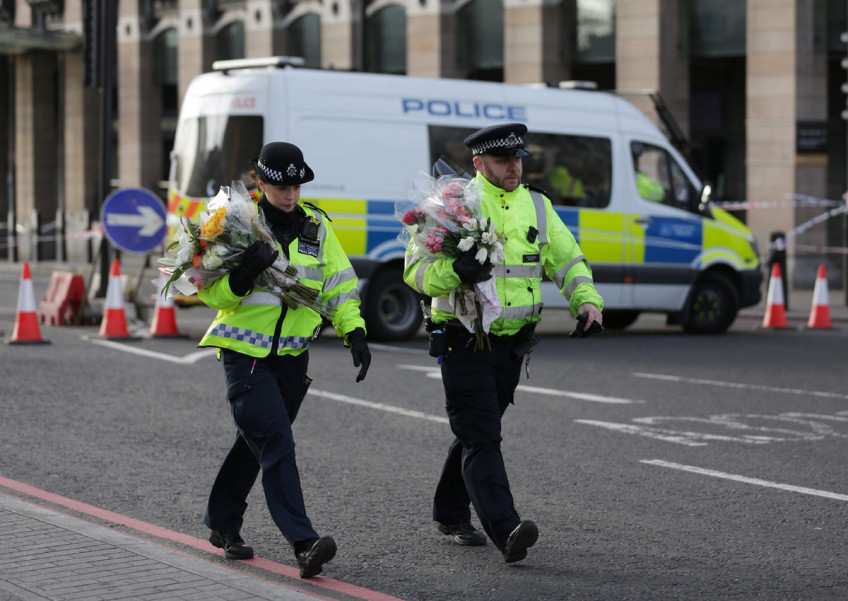Attack forces urgent review of country's security measures


British government and intelligence officials are urgently reviewing the country's security procedures in the wake of the worst terrorist attack in over a decade.
Four people died and about 40 others were injured in the terrorist attack in London on Wednesday.
The assailant, using his car as a weapon, first ploughed into pedestrians on the pavement along Westminster Bridge.
After smashing his vehicle into the perimeter railings outside the Palace of Westminster, he ran into the grounds of Parliament, where he stabbed to death a police officer before being gunned down himself.
The deadly rampage, reminiscent of similar attacks in other parts of Europe last year, flags ominous developments in international terrorist trends.
Instead of logistically complex assaults involving bombs and multiple participants, a single assailant armed with no more than a knife and a car was able to strike with deadly effect.
Read Also: British parliament attack: What we know
To be sure, some of the initial lessons to be drawn from Wednesday's incident are encouraging for the authorities.
While the assailant did manage to get past the first cordon of policemen at the entrance to the parliamentary buildings, he was shot well before he had any chance of getting near the MPs and members of the House of Lords who worked inside, precisely as security procedures envisaged.
The first ambulances were at the scene to tend to the victims within three minutes after the attack began, well inside the eight-minute planned target response time for such emergencies.
And a lot of other details not evident to the untrained eye also worked as intended.
Security forces were present in sufficient numbers not only to rebuff and kill the perpetrator, but also to meet the eventuality - considered real at the time of the attacks - that he might have had associates elsewhere, ready to launch attacks on other targets in London at the same time.
The presence of police helicopters and the locking down of much of the centre of London may have seemed excessive, but were an essential part of the response strategy.
Furthermore, the fact that the assailant used a car and a knife to mow down and stab people serves as a reminder that Britain's strict gun laws seem efficient enough to drive terrorists towards "weaponising" everyday tools, rather than using more deadly firearms.
Still, the attack in London confirms a disturbing shift in politically motivated violence, first seen in France and then in Germany, whereby terrorists aim to kill as many people as possible by running them over with vehicles.
Security services in Britain and many other countries are now urgently reviewing their preventive measures in order to limit the destructive potential of such attacks; expect many more restrictions on all vehicles in areas where crowds gather, as well as the placing of sturdy obstacles on pavements at key spots where large numbers of people are expected to pass.
Defences around Whitehall, an area of 1km in radius in central London where Parliament and most key government departments are to be found, have already been strengthened considerably during the past two decades.
There is a two-layer steel and concrete physical barrier restricting the road adjacent to the Parliament building.
Access to Downing Street, the British Prime Minister's official residence, is also heavily restricted and a variety of other barriers - mostly made of steel but disguised as stone structures designed to look suitably ancient - protect pedestrians across the adjacent pavements.
Read Also: Indonesians in London asked to remain vigilant following attack
Nevertheless, the pavements on the bridge over the Thames river which leads to the iconic Big Ben tower has almost no protective devices, and the gate through which MPs walk or drive their cars into Parliament remains strangely vulnerable.
Until now, it was protected by two makeshift police barriers which can be set aside by a single person, and a few "bobbies" greeting passers-by with the familiar "Good morning".
All very British but all will have to change.
The gates will now have to be secured with permanent structures, and traffic in the square facing Big Ben may have to be curbed.
Security services will also have to take another look at arrangements protecting the Parliament building from the river; this is a preventive work which never ends.
The investigation into the attack continues.
Read Also: S Korean tourists among injured in Westminster Bridge attack which killed 4
British Prime Minister Theresa May's decision to chair a meeting of the Cobra emergency committee in the wake of the attack and arrests made in police raids across Britain yesterday raise further questions about how intelligence services should monitor and identify radicalised individuals.
But the response of ordinary Londoners also confirmed the city's resilience.
"The flower that blooms in adversity is the rarest and most beautiful of them all," read a note scribbled by workers at one station on London's underground system which had to close due to the terrorist attacks.
Passers-by stopped, read the notice and smiled.
[embed]https://studio.brightcove.com/products/videocloud/media/videos/5369334262001[/embed]
jonathan.eyal@gmail.com

This article was first published on March 24, 2017.
Get a copy of The Straits Times or go to straitstimes.com for more stories.